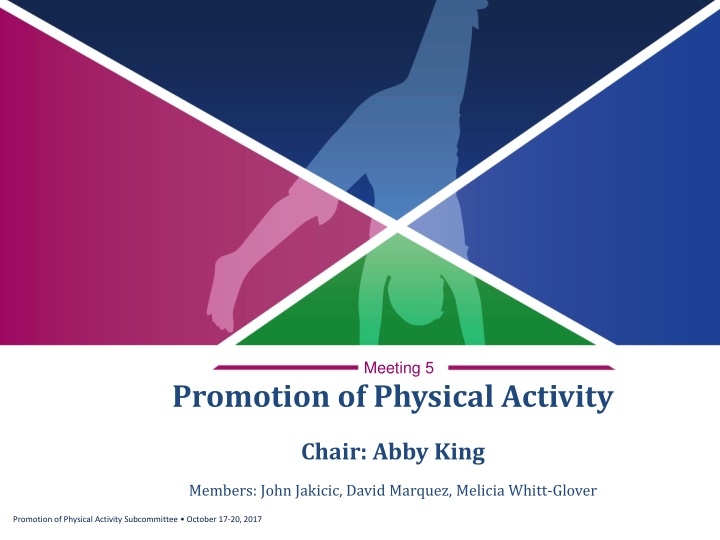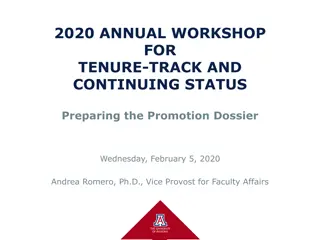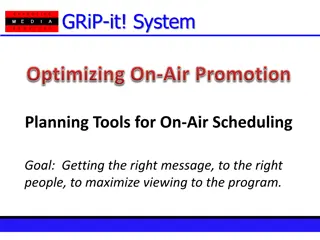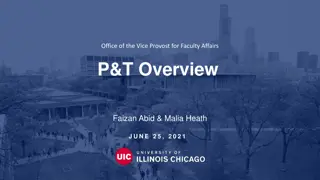
Effective Strategies for Promoting Physical Activity in Different Populations
Discover effective intervention strategies for increasing physical activity and reducing sedentary behavior in various demographics. Explore a systematic review of evidence-based practices and interventions for enhancing health outcomes through physical activity promotion.
Download Presentation

Please find below an Image/Link to download the presentation.
The content on the website is provided AS IS for your information and personal use only. It may not be sold, licensed, or shared on other websites without obtaining consent from the author. If you encounter any issues during the download, it is possible that the publisher has removed the file from their server.
You are allowed to download the files provided on this website for personal or commercial use, subject to the condition that they are used lawfully. All files are the property of their respective owners.
The content on the website is provided AS IS for your information and personal use only. It may not be sold, licensed, or shared on other websites without obtaining consent from the author.
E N D
Presentation Transcript
Meeting 5 Promotion of Physical Activity Chair: Abby King Members: John Jakicic, David Marquez, Melicia Whitt-Glover Promotion of Physical Activity Subcommittee October 17-20, 2017
Experts and Consultants Consultants: Matthew P. Buman, Ph.D. Arizona State University Melissa A. Napolitano, Ph.D. The George Washington University ICF Staff: Bethany Tennant, Ph.D. Federal Liaison: Janet Fulton, Ph.D., FACSM 93 Promotion of Physical Activity Subcommittee October 17-20, 2017
Subcommittee Questions 1. What interventions are effective for increasing physical activity at different levels of impact? a) Does the effectiveness vary by age, sex, race/ethnicity, or socio-economic status? 2. What interventions are effective for reducing sedentary behavior? 94 Promotion of Physical Activity Subcommittee October 17-20, 2017
Social Ecological Framework Technology Environment / Policy Community Individual Promotion of Physical Activity Subcommittee October 17-20, 2017
Question #1 What interventions are effective for increasing physical activity at different levels of impact? Source of evidence to answer question: Systematic reviews Meta-analyses Pooled analyses Existing reports Focus on identifying areas for which sufficient evidence exists to assign an evidence grade 96 Promotion of Physical Activity Subcommittee October 17-20, 2017
Analytical Framework Systematic Review Question 1 What interventions are effective for increasing physical activity at different levels of impact? Target Population People of all ages Intervention/Exposure Physical activity intervention(s) at different levels of impact Information Technology Built Environment and Policy/Legislation Community Settings (2 updates) Individual (2 updates) Key Definition Intervention:any kind of planned activity or group of activities (including programs, policies, and laws) designed to prevent disease or injury or promote health in a group of people, about which a single summary conclusion can be drawn (The Community Guide http://www.thecommunityguide.org/ about/glossary.html). Endpoint Health Outcome Physical activity behavior change 97 Promotion of Physical Activity Subcommittee October 17-20, 2017
Updates to Community-Level Conclusion Statements As a consequence of continuing experience with the grading system across different levels & further evaluation of articles & subcommittee deliberations Schools Multi-component interventions Strong evidence that interventions that impact multiple components of schools are effective for increasing PA during school hours in primary school-aged and adolescent youth. PAGAC Grade: Strong Physical education class interventions Strong evidence that interventions that revise the structure of physical education (PE) classes are effective for increasing in-class PA in primary school-aged and adolescent youth. PAGAC Grade: Strong 98 Promotion of Physical Activity Subcommittee October 17-20, 2017
Updates to Individual-Level Conclusion Statements Older Adults Strong evidence that PA interventions that target older adults have a small, positive effect on PA when compared with minimal or no-treatment controls, particularly over time periods of 6-12 months. PAGAC Grade:Strong Theory-Based Behavioral Interventions Strong evidence that theory-based interventions and behavior change techniques are effective for increasing PA levels in general adult populations compared with interventions that are not theory- based. PAGAC Grade: Strong 99 Promotion of Physical Activity Subcommittee October 17-20, 2017
Environment & Policy: Definition Environmental and policy level interventions broadly include those features of a locale that relate directly to the built environment (e.g., access to parks, trails, recreational facilities; pedestrian or bicycling infrastructure), or to laws, local ordinances, organizational policies, and institutional practices that can impact physical activity levels. Evidence depends more heavily on observational studies (though increasing number of longitudinal designs, quasi-experimental designs, & natural experiments). 100 Promotion of Physical Activity Subcommittee October 17-20, 2017
Search Results Environment & Policy: Reviews1 and Reports Identification High-quality reports searching N = 27 PubMed database searching N = 1734 Cochrane database searching N = 593 CINAHL database searching N = 89 Records after duplicates removed N = 1778 Screening Titles screened N = 1778 Excluded based on title N = 1307 Excluded based on abstract N = 264 Abstracts screened N = 471 Eligibility Full text reviewed N = 207 Excluded based on full text N= 198 Articles included from supplementary strategies N= 4 Included Articles included N = 13 101 Promotion of Physical Activity Subcommittee October 17-20, 2017 1 Reviews include systematic reviews, meta-analyses, and pooled analyses.
Draft Conclusion Statements: Environment & Policy level Strong evidence that interventions that target point of decision prompts to use stairs vs. escalators or elevators are effective in increasing short term stair use among adults. PAGAC Grade: Strong Moderate evidence that having access to indoor and/or outdoor recreation facilities or outlets, including parks, trails, and natural or green spaces, is positively associated with PA among adults and children. PAGAC Grade: Moderate 102 Promotion of Physical Activity Subcommittee October 17-20, 2017
Draft Conclusion Statements (continued): Environment & Policy level Moderate evidence that built environment characteristics and infrastructure that support active transport to destinations (e.g., safe routes to school programs, street connectivity, a mix of connected residential, commercial, and public land uses) are positively associated with walking and cycling for transport among children, adults, and older adults. PAGAC Grade: Moderate Moderate evidence that community design and characteristics that support PA, such as having safe and readily usable walking and biking infrastructure and other favorable built environment elements are positively associated with recreational forms of PA among children and adults. PAGAC Grade: Moderate 103 Promotion of Physical Activity Subcommittee October 17-20, 2017
Draft Key Findings - Examples of Evidence: Point of Decision Prompts to Take Stairs Studies conducted in different community settings (e.g., transit hubs, worksites, hospitals); used behavioral observation Designs included A-B-A, pre-post, & similar quasi-exptal. In 1 SR [Jennings, 2017] of 67 studies, 77% reported increases in post-intervention stair use (2/3 had study durations of <12 wks.) In studies with significant effects (n=55 studies), increases in % stair use ranged from 0.3% - 34.7% Odds ratios ranged from 1.05 (95% CI: 1.01 1.10) to 2.90 (95% CI: 2.55 3.29) When reported, these effects were observed across population subgroups varying in age, sex, weight status 104 Promotion of Physical Activity Subcommittee October 17-20, 2017
Draft Key Findings - Examples of Evidence: Access to Recreational Facilities or Outlets Access measures included objective [GIS] & some perceived measures; mix of cross- sectional & longitud. In Adults, greater access was sig. related to more PA (e.g., [MA=16 studies] Odds Ratio = 1.20 [95% CI: 1.06 1.34]) (Duncan, 2005) In Youth, 9 of 13 studies showed sig. relations between access and PA, particularly for girls (Mozaffarian, 2012) Evidence related to population subgroups generally limited 105 Promotion of Physical Activity Subcommittee October 17-20, 2017
Draft Key Findings - Examples of Evidence: Active Transport (walking, cycling) Environmental measures included GIS & self-report; mix of cross- sectional & longitud In Adults, a large natural expt. [RESIDE] & multiple smaller prospective quasi-exptal. studies found sig. increases in active transport over time in response to supportive environ. characteristics (e.g., walkability, land-use mix/destinations) In 7 studies prospectively comparing more vs. less activity-supportive environs., higher transport walking in former (median = 38 more mins/wk) In Youth (from 8 SRs), activity-supportive environs positively associated with active transport, particularly to school. Odds ratios ranged from 1.8 (95% CI: 1.05 3.42) to 3.46 (95% CI: 1.6 7.47). In Older Adults, MA of 42 studies (Cerin, 2017) found sig. positive associations with walkability components (e.g., res. density, street connectivity, land-use mix) 106 Promotion of Physical Activity Subcommittee October 17-20, 2017
Draft Key Findings - Examples of Evidence: Recreational PA In 7 studies comparing more vs. less activity-supportive environs., Adults in activity-supportive neighborhoods reported median of 50.4 more mins/week of MVPA In 19 studies evaluating neighborhood walkability indices (combination of res. density, street connectivity, land-use mix), 2/3 reported higher levels of MVPA associated with higher walkability scores In Adults, e.g., positive association between higher walkability index & PA yielded OR = 2.4 (95% CI: 1.18-4.88) (Feng, 2010) In Youth, e.g., positive association between higher walkability index & PA yielded OR = 1.9 (95% CI: 1.04-3.59) (Feng, 2010) 107 Promotion of Physical Activity Subcommittee October 17-20, 2017
Draft Evidence for 2nd part of Question #1 a) Does the effectiveness vary by age, sex, race/ethnicity, or socio-economic status? Evidence (similar to other levels) insufficient to determine an evidence grade 108 Promotion of Physical Activity Subcommittee October 17-20, 2017
Policy Interventions Defined as: Laws, local ordinances, organizational policies, and institutional practices that can impact physical activity levels. 1 formal review located; mostly descriptive in nature 1 prospective study described in the Community Guide (2017) that evaluated impacts of policies on sprawl found significant positive impacts on transport & recreational activity Insufficient evidence to provide an Evidence grade 109 Promotion of Physical Activity Subcommittee October 17-20, 2017
Draft Implications: Environment & Policy level Contextual factors related to built environments areimportant to take into account when developing PA Promotion interventions A number of different settings can be included in promoting PA-friendly environments, such as schools, worksites, transit hubs, parks, neighborhoods, and residential settings Less information currently available related to rural environments and factors influencing PA behavior, relative to more urban environments Relatively little systematic evidence available evaluating effects of policies related to sprawl, land-use mix, and other factors on different types of PA and for different population segments 110 Promotion of Physical Activity Subcommittee October 17-20, 2017
Draft Research Recommendations: Environment & Policy level Systematically examine built environment characteristics as moderators of PA interventions at other levels of impact (individual, community, technology) Examine the mixof these factors among different age, gender, cultural, geographic, and socio-economic groups Evaluate combined effects of environmental characteristics and cultural/ social contexts & preferencesfor participating in physical activity Expand research on environment prompts for activity, including uses of technology at decision points for PA Further examine environmental characteristics in different settings (i.e., rural vs urban, school, worksites) & how they can be modified to promote PA Broaden the reach of environmental interventions to sociodemographic populations at highest risk for physical inactivity Systematically examine the impacts of policies (e.g., Safe Routes to Schools, sprawl regulation) on physical activity for different population segments 111 Promotion of Physical Activity Subcommittee October 17-20, 2017
Committee Discussion 1. What interventions are effective for increasing physical activity at different levels of impact? a) Does the effectiveness vary by age, sex, race/ethnicity, or socio-economic status? 112 Promotion of Physical Activity Subcommittee October 17-20, 2017
Question #2 What interventions are effective for reducing sedentary behavior? Definition of Sedentary (SED) Behavior Interventions Strategies that seek to reduce sedentary behavior outcomes, which may include self-reported or context-specific forms of sedentary behavior (e.g., television viewing), accelerometer- or movement- based outcomes, or posture-based outcomes (e.g., lying or seated behaviors at <1.5 METs) 113 Promotion of Physical Activity Subcommittee October 17-20, 2017
Analytical Framework Systematic Review Question 2 What interventions are effective for reducing sedentary behavior? Target Population People of all ages Intervention/Exposure Sedentary behavior reduction intervention(s) Key Definition Endpoint Health Outcome Sedentary (SED) Behavior Interventions: Strategies that seek to reduce sedentary behavior outcomes, which may include self- reported or context-specific forms of sedentary behavior (e.g., television viewing), accelerometer- or movement-based outcomes, or posture-based outcomes (e.g., lying or seated behaviors at <1.5 METs). Sedentary behavior change 114 Promotion of Physical Activity Subcommittee October 17-20, 2017
Q2 Search Results Reviews1 and Reports Identification PubMed database searching N = 1734 Cochrane database searching N = 593 CINAHL database searching N = 89 High-quality reports searching N = 27 Records after duplicates removed N = 1778 Screening Titles screened N = 1778 Excluded based on title N = 1307 Excluded based on abstract N = 264 Abstracts screened N = 471 Eligibility Full text reviewed N = 207 Excluded based on full text N= 190 Included Articles included N = 17 115 Promotion of Physical Activity Subcommittee October 17-20, 2017 1 Reviews include systematic reviews, meta-analyses, and pooled analyses.
Description of the Evidence 3 Sub-categories (that emerged from the search): Youth: 8 reviews (4 MA, 4 SR); 130 studies Adults: 5 reviews (3 MA, 2, SR); 201 studies Worksites: 4 reviews (2 MA, 2 SR); 101 studies 116 Promotion of Physical Activity Subcommittee October 17-20, 2017
Draft Conclusion Statement: Youth Moderate evidence that interventions targeting youth (ages 3-15 yrs.), primarily through reductions in TV viewing and other screen-time behaviors in community & school settings, have small but consistent effects on reducing sedentary behavior. PAGAC Grade: Moderate 117 Promotion of Physical Activity Subcommittee October 17-20, 2017
Draft Key Findings: Youth Majority of studies at least 6 months in duration, with no pattern of efficacy based on intervention length; few data on sustainability of sedentary reductions once intervention ended Occurred in a range of settings (e.g., community, clinical, school) Some targeted sedentary behavior exclusively, while others included it in multiple behavior change interventions (i.e., primarily SED + PA; some also included diet) In one review, reductions in sedentary time averaged 20.4 mins/day (95% CI: -30.69 to -10.20) mins/day In School interventions targeting reduced screen time, SMD= -0.25: (95% CI: -0.37 to -0.13) hours/day Accelerometer-based studies generally showed greater reductions in sedentary behavior than studies with self-reported outcomes 118 Promotion of Physical Activity Subcommittee October 17-20, 2017
Draft Conclusion Statement: Adults Limited evidence that sedentary behavior interventions targeting decreases in overall sedentary time in general adult populations are effective. PAGAC Grade: Limited 119 Promotion of Physical Activity Subcommittee October 17-20, 2017
Draft Key Findings: Adults Interventions targeting SED behavior exclusively had most promising effects (SMD= -41.76; CI: -78.92, -4.60), but were of short duration (< 3 months), limited follow-up, & had other methodological constraints Interventions targeting PA had small to no effect on SED behav. (in 1 review, 6/19 [32%] had sig. effects; their SMD = -0.22 [-0.35 to -0.10]) Multiple behav. Interventions (SED + PA and/or diet) had small & variable effects on SED (in 1 review, 6/20 [30%] had sig. effects, their SMD = -24.18 [95% CI: -40.66,-7.70]) 120 Promotion of Physical Activity Subcommittee October 17-20, 2017
Draft Conclusion Statement: Worksites Moderate evidence that interventions targeting sedentary behavior in worksites particularly among office workers who perform their job duties primarily while seated have moderate to large short-term effects in reducing sedentary behavior. PAGAC Grade: Moderate 121 Promotion of Physical Activity Subcommittee October 17-20, 2017
Draft Key Findings: Worksites Environmental changes (predominantly addition of sit-stand workstation, & some treadmill desk or stationary cycle ergometer studies) had consistently medium to large effects (SMD = -72.78 [-104.92, -40.64 mins/8-hour workday]). These effects were stronger when environmental changes were combined with educational & behavioral support (SMD = -88.80 [95% CI: -132.69, -44.61 mins/8-hour workday]) Walking workstations and cycle ergometers appear to have more limited efficacy compared to sit-stand workstations at reducing workplace sedentary time (i.e., sitting) Interventions providing educational or motivational support only showed small and inconsistent effects on sedentary behavior (SMD = -15.52 [-22.88,-8.16 mins/8-hour workday]) 122 Promotion of Physical Activity Subcommittee October 17-20, 2017
Draft Implications: Sedentary Interventions SED interventions may complement PA interventions given that they can be implemented during times when PA is generally not feasible (e.g., during school class time, work time). Overall, targeted approaches to SED behavior reduction appear more efficacious than broader-based lifestyle interventions which include reducing sedentary time. Environmental supports (e.g., sit-stand workstations) may be necessary for substantive changes in sedentary time in work settings, particularly among office workers & similar jobs. Across subgroups, objective SED assessments consistently captured stronger effects than self-report, & postural sensors that distinguish sitting vs. standing had stronger intervention effects than accelerometer-based sensors. 123 Promotion of Physical Activity Subcommittee October 17-20, 2017
Draft Research Recommendations Specifically target behavioral & environmental strategies for reducing overall sedentary time Evaluate intervention strategies that target the full waking day (e.g., magnitude of total sedentary change, and explore behavioral compensation) Broaden enrollee targets to increase diversity & generalizability (e.g., racial/ethnic minority & lower- income children and adults, non-office workers, and individuals with varying job types and schedules) Evaluate behavioral relations and synergies between changes in sedentary behavior and PA in different populations 124 Promotion of Physical Activity Subcommittee October 17-20, 2017
Committee Discussion What interventions are effective for reducing sedentary behavior? 125 Promotion of Physical Activity Subcommittee October 17-20, 2017
Next Steps WRITE WRITE SOME MORE KEEP WRITING 126 Promotion of Physical Activity Subcommittee October 17-20, 2017






















